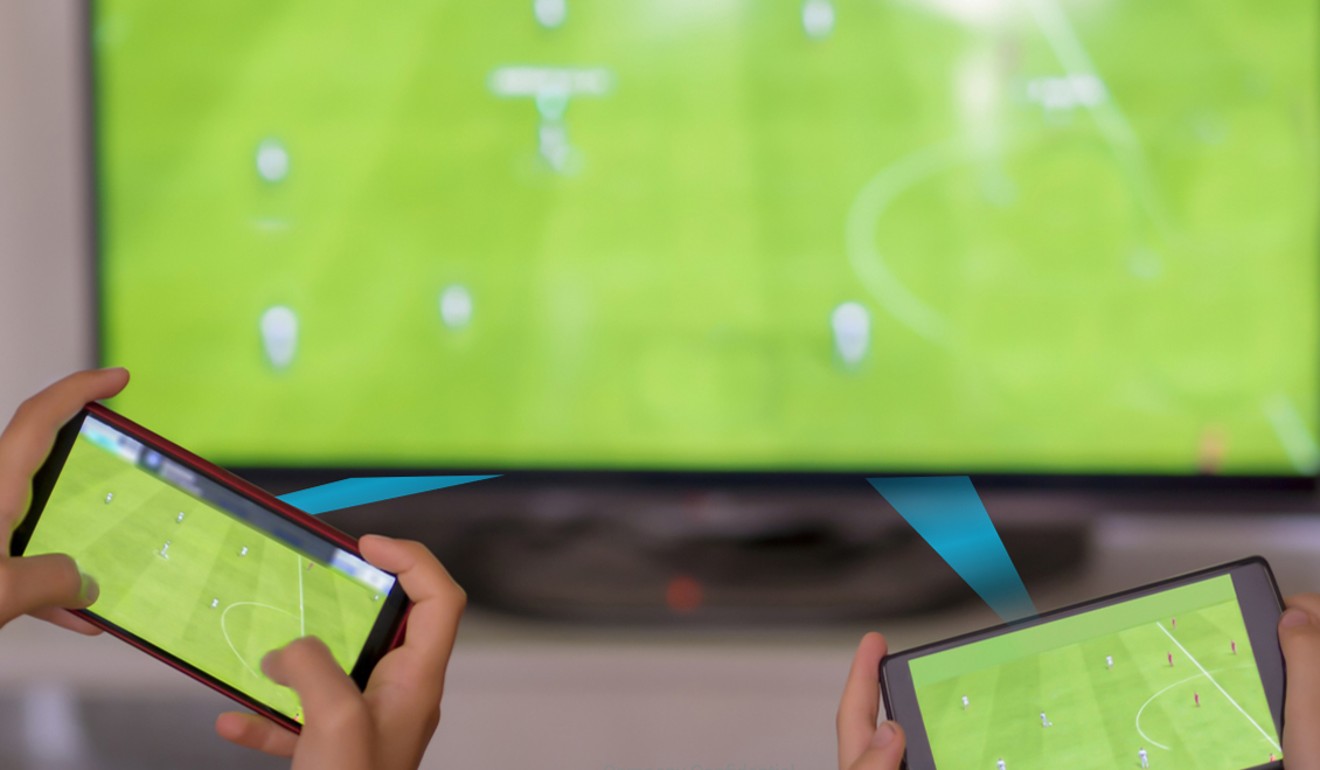
Light bulb moment: how LED could provide a faster, stronger, more secure mobile wireless connection
- Tests underway on Li-fi – ultra-high speed light fidelity technology
- Technology will complement Wi-fi, which faces competition for increasingly limited bandwidth on radio spectrum
Consumers have become so internet-dependent that it’s hard to imagine it won’t always be there.
However, the radio spectrum that covers 3G, 4G, 5G, Wi-fi, Bluetooth, digital radio and 4K television is finite.
Even the best connections struggle to cope with heavy demand and it’s only going to get worse as more people, devices and services connect and compete for the limited bandwidth.
Imagine a world where high-speed connectivity is as pervasive as the lights in our ceilings ... imagine billions of lights connecting billions of smart devices unlocking unprecedented productivity
Yet what if you could get a stronger, faster, more secure connection from an ordinary light-emitting diode light bulb?
That’s the potential of light fidelity, or Li-fi, a mobile wireless technology that uses light, rather than radio frequencies, to send data.
One of the companies developing the technology, pureLiFi, said: “Imagine a world where high-speed connectivity is as pervasive as the lights in our ceilings, our streets and our homes.
Video doorbell and 4 other ‘invisible’ smart home devices to keep you in control without being seen
“Imagine billions of lights connecting billions of smart devices unlocking unprecedented productivity, autonomy and fuelling the next generation of high bandwidth disruptive applications, such as autonomous systems, artificial intelligence, edge computing and augmented reality.”

Sarah Scace, pureLiFi’s director of marketing and communications, said the biggest impact for the user will be the quality of experience.
“Everyone has experienced an overloaded network at home,” she said. “If users in a single home are streaming video, online gaming and surfing the internet all at once, it's very likely nobody has the best user experience.
“This may not be a result of the connection to the home, but instead having too many users and applications accessing the wireless network simultaneously.”
[Li-fi technology will complement Wi-fi] ... and be used for video streaming [and] gaming, due to its ultra-high speed and low latency characteristics. Wi-fi can then be used for surfing and emailing
Li-fi technology will complement, rather than replace, the existing Wi-fi, Scace said.
“Li-fi can be used for video streaming, gaming and so on, due to its ultra-high speed and low latency characteristics. Wi-fi can then be used for surfing and emailing. This way everyone gets the best experience possible.”
She said if you imagine Li-fi as a massive multi-lane motorway and Wi-fi is a single lane road, you drive the largest trucks on the largest roads and free up the lanes for the smaller cars.
“As the technology matures, we expect Li-fi to be pervasive throughout the entire home, augmenting and enhancing wireless [connection] everywhere and opening up massive bandwidth for everyone.”

The technology is a solution to the interference often experienced in densely populated areas, such as large blocks of flats or urban centres.
Cool running: hi-tech ideas pull plug on air conditioners that add to global warming
“Interference is invisible, so the user doesn't even know that's why they were getting [the internet connection speed of] 20 megabits per second [Mbps] when their internet service provider promised them 500Mbps,” Scace said.
“This is because uncoordinated and over-deployed Wi-fi leaks through walls into other apartments or rooms and causes all kinds of signal quality issues.
“With the increase in connected devices, this problem is only getting worse,” she said.
“Li-fi eliminates this problem. Li-fi doesn't leak through walls, isn’t interfered with by radio frequencies and you can visually see the coverage, which prevents interference altogether.”

The same reason that Li-fi prevents interference means it will also provide superior online privacy.
Scace said: “A Li-fi signal will not be accessible from a nearby home. Li-fi doesn't pass through walls, which means you can secure your network by drawing the curtain and locking the door.
A Li-Fi signal will not be accessible from a nearby home ... this wireless network could hold your most private digital items such as passwords, family photographs or financial information and would be virtually unhackable
“In times where home Wi-fi networks can be sniffed from three homes away and be hacked using simple online tools, this can provide peace of mind.”
With Li-fi, users could also host a private wireless network in their home that is not connected to the internet.
“This wireless network could hold your most private digital items such as passwords, family photographs or financial information, and it would be virtually unhackable,” Scace said.
Although still a young technology, Li-fi is already delivering 1Gbps in a single channel in form factors small enough to fit in a mobile handset.
In the laboratory, researchers at the University of Edinburgh’s LiFi Research & Development Centre have demonstrated over 10Gbps with a single LED, Scace said.
Electric vehicles are here to stay in Hong Kong – and on the charge
“It won’t be long before Li-fi is the fast wireless technology, placing huge amounts of speed and bandwidth in your hand.”
Alistair Banham, pureLiFi’s CEO, who demonstrated the first Gigabit Li-fi components ready for mobile devices at February’s Mobile World Congress in Barcelona, said that now is the time for Li-fi to be used by consumers.
“The new optical components will, for the first time, allow mobile device manufacturers to start designing Li-fi into mobile handsets,” he said.
“The ecosystem is crying out for new spectrum and new wireless technology that will service the global appetite for more bandwidth and digital innovation.
The world is heading towards bandwidth crunch and Li-fi will solve this problem ... mass deployment will most likely occur in a plan similar to Wi-fi
“Device manufactures need new technology to be sure they’re ready for 5G and differentiate from their competition.”
His company’s technology is being tested in more than 130 places in 23 different countries.
Meanwhile, Signify, the new company name of Philips Lighting, said it is working with more than 30 customers in Europe, North America and Asia to test its commercial Li-fi system.
Singapore’s Republic Polytechnic, which has installed Li-fi at its Smart Devices Lab, is the first institute of higher learning in Southeast Asia to adopt the technology.
“Our initial [tests] illustrate the massive potential of this technology,” Michel Germe, head of Li-fi at Signify, said.
“We’ve received hundreds of inquiries from potential customers from all corners of the world, some of which have led to applications inspired by them and jointly created with them, such as communication between robots in manufacturing facilities.
“As well as the 30 plus [test] projects, we’ve installed Li-fi in 26 of our buildings across the world.”
Gary Mackenzie, founder and CEO of Australian company nextLiFi, which has offices in Hong Kong and Singapore, said this next generation of wireless technology is not only faster and more secure, but also greener and more cost-effective to deploy than Wi-fi.
Why hi-tech, interactive fitness workouts in the home and office are next big trend
In terms of consumer use, the technology is ahead of the hardware, he said.
Currently, users need to insert a special dongle into their devices to connect with Li-fi, but this will be avoided once smartphone and computer manufacturers install a Li-fi chip in devices.
“Consumers mostly access the internet with their mobile phones,” he said. “Until Apple or Samsung release a phone that is compatible to receiving light [beyond the small amount of light its camera can receive] adoption will be restricted.”
Our initial [tests] illustrate the massive potential of [Li-fi] technology. We’ve received hundreds of inquiries from potential customers from all corners of the world
While waiting for the handset companies to catch up, his company is targeting the commercial and industrial side of the industry.
“We’re focused on getting buildings Li-fi ready, with infrastructure to then deploy Internet of Things applications, such as security and door access, and putting chips into appliances to create a Li-fi ecosystem,” he said.
The company expects its system will be available for home use by 2021.

Beyond the smart home, the technology is set to transform the way we shop, travel, and go about our daily business, Mackenzie said.
“Our retail brand, LIFIC (Li-Fi Communications), planned for launch in early 2020, will give retailers the ability to send promotions to consumers’ handsets, displaying daily specials and offers within a shopping complex, or high street environment.”
Will superfast 5G internet really change the world?
Mackenzie said the public roll-out of the technology could happen as soon as next year.
“LIFIC’s retail wireless infrastructure will leverage both corporate brands and public spaces, enhance tourism, cultural arts, museums and historic locations to [boost] the visitor experience through smarter and safer engagement,” he said.
Mackenzie said nextLiFi is collaborating with a number of universities in Australia, Singapore and Malaysia to develop its technology and has demonstrated its capability at various projects abroad.
He is convinced that light is the future of wireless communication.
“The world is heading towards bandwidth crunch and Li-fi will solve this problem,” he said.
Deployment of the new technology will involve teaming up with telecom companies.
Mackenzie said: “Mass deployment will most likely occur in a plan similar to Wi-fi. We are in discussions with a few telecom companies on commercial applications and various research applications.”
Scace said: “We very much plan to work with telecom and infrastructure providers. We have done a trial with 02 Telefonica in Britain.”

